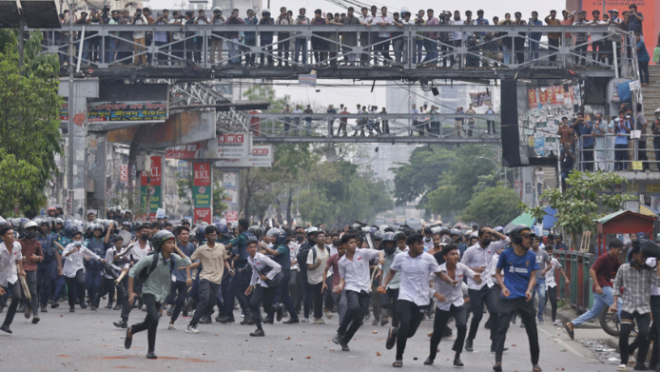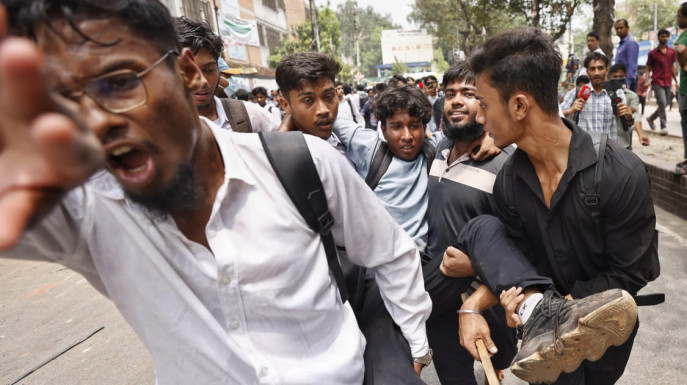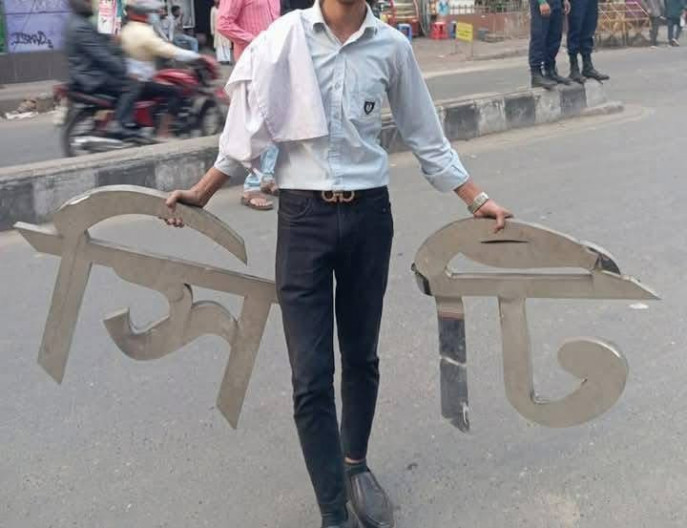What's really fuelling the never-ending Dhaka College vs City College brawls?
What's really fuelling the never-ending Dhaka College vs City College brawls?

“City College boys don’t want the girls from their college dating guys from other colleges. But Dhaka College doesn’t even have girls! Thing is, girls date boys from all three colleges anyway. That’s why fights keep breaking out!”—shared a group of City College girls, quite casually, in conversation.
At first glance, the tension might seem silly. But the consequences are very real—just ask Jahangir Alam, who owns a mirror shop in the Science Lab area. With a college on either side of his shop and fights erupting like clockwork, he lives in constant fear of a brick shattering his glassware.
“They’ve turned fighting into part of the daily routine,” he said, exhausted.
Anyone who scrolls through news feeds or social media these days would likely agree. The clashes between students of Dhaka College and City College are no longer rare occurrences. It takes very little for the Science Lab area to turn into a battlefield—costing the city peace, traffic flow, and in many cases, people’s livelihoods.
When fighting becomes the new normal
It was Tuesday, 21 April. Dhaka College students were already on edge. The previous day, one of their classmates had allegedly been attacked—supposedly by City College students. The mood was simple: revenge.

Around 11:30 AM, a group of students from Dhaka College headed towards City College. What followed was a round of brick-throwing, chasing, and general chaos. Police managed to bring things under control within an hour. But by 2 PM, it flared up again—more clashes, more injuries, some of them shopkeepers caught in the crossfire.
And this wasn’t an isolated event. According to residents and shopkeepers in the area, such clashes are now expected. In just the past eight months, students from three nearby colleges have clashed over 13 times—most frequently between Dhaka College and City College.
The latest face-off before this one happened on 15 April. Barely a week passed before tensions flared again.
“It’s too much”
Back in November, there were clashes. Then again in January, not once but twice. February? Four separate incidents. And then it just kept going—chases, thrown bricks, torn-off signboards. Hundreds have been injured over time.
Mokaddes Matubber, who has been selling jhalmuri and velpuri in front of City College for 28 years, shared a recent memory:
“There were 200 boys beating up one guy. I couldn’t take it anymore. I went and said, ‘Mama, he’s had enough, please stop!’ They turned to me and said, ‘Move or we’ll beat you too.’”
Witnesses say, during fights, it’s as if all sense of reason disappears. Armed with bricks and sticks, students rush at each other, often turning merciless the moment someone from a rival college is within reach.
The city pays the price
No one suffers more than the people just trying to get by—pedestrians, roadside vendors, shopkeepers. A single brick could strike anyone. Many close up shop as soon as a fight begins. But those working on the footpaths can’t afford to walk away.
Science Lab is one of Dhaka’s busiest junctions. It connects multiple major roads. So, when fighting starts, traffic comes to a standstill.
A Savar Paribahan bus driver recalled being stuck for five hours during a clash last year. “Sometimes the whole day gets wasted. And we fear for our buses—students attack those too,” he said.
Jahangir Alam, who’s been in the mirror business for 47 years (15 of them at his current location), said earlier the fights were occasional. “Now, the moment it starts, we have to shut the shop. No other option. Bricks start raining like it’s a storm.”
Shopkeepers can at least shut their doors. But what about street vendors?
Wahab Mollah sells photo frames near Dhaka College. He’s young and scared. “The moment it starts, you have to run. You never know who’s hitting who.”
One pedestrian summed it up in frustration:
“Move the two colleges to opposite ends of the city. Their year-round drama is unbearable!”
Netizens fire back with sarcasm
“Whatever Dhaka College, City College, or Ideal College are up to—it’s not fighting, it’s their annual festival!” wrote a former student on Facebook. “I took part once, back in 2019. Found out what the fight was about three days later!”
Social media is full of satire, jokes, and rage, especially from former students who’ve been through the cycle themselves.

Writer Shoaib Sorbon shared a list of mock solutions for these college fights. He suggested setting a fixed date, renting out a park from the City Corporation for “battle days,” and banning all weapons except bamboo sticks—whose size and weight would be regulated by BUET researchers.
“There should be a medical camp nearby,” he added.
To complete the spectacle, he proposed each college get custom t-shirts and trousers in different colours.
“And the winning college’s boys get bragging rights: no other college boys can smoke in front of them that year. If they cross paths, they must greet them with respect and call them ‘bhai’.”
He even proposed forming a high-level committee with intellectuals to preserve this ‘tradition’ of campus fighting.
Some aren’t laughing
Not everyone finds it funny anymore. Dr Kamrul Hasan Mamun, a Dhaka University professor, wrote on Facebook:
“Dhaka College and City College students keep clashing over the most trivial things. Not just them—we’ve seen fights between halls in the same university as well.”
He added, “What all this really shows is that we are drifting further into uncivil behaviour. We must think deeply about how to change this.”
So, why does this keep happening?
Johnny Rahman, a recent MA graduate from Dhaka College’s English department, thinks it often starts with something personal.
“Say, a Dhaka College student goes near City College and gets beaten up due to some previous grudge. He comes back, posts in his dorm group or on Facebook that City College guys attacked him for no reason. And then, boom—everyone wants revenge,” he said.

In his view, small provocations keep reigniting old feuds. “Even if a fight is over, let’s say a bus from Dhaka College is passing through Science Lab. Someone throws a brick at it. And then it starts all over again.”
According to one student, nearly 60% of inter-college clashes stem from rivalry and resentment built up between neighbouring institutions.
Take the recent incident, for example, where students from Ideal College reportedly took down the nameplate of Dhaka City College. The tension isn’t new—it’s just the latest episode in a longstanding, often violent, turf war.
Sadia Rahman (pseudonym), a student at City College, believes much of this violence is rooted in pride. “We’re neighbouring colleges, but no one can stand each other. Even if two people don’t know each other personally, the moment they find out one is from Dhaka College and the other from City College, the atmosphere changes,” she said.
She also pointed fingers at the over-the-top emotions of newly admitted HSC students. “It’s always the college kids in intermediate. Especially second-year boys. They’re the ones eager to show power, and it ends in fights.”
When fights start with flirting
A group of City College girls shared a more specific reason behind many brawls: romance.
“The boys here want the girls to only date boys from our own college. But Dhaka College doesn’t even have girls! Still, the girls end up dating guys from all three colleges. And that’s how fights break out,” said one of them, half-jokingly.
Johnny Rahman, a Dhaka College student, backed the claim—stating that love-related issues were responsible for around 40% of the clashes.
Locals echoed similar views. Many also blamed aggressive Facebook posts, verbal taunts, damaged college buses, and occasional ambushes.
On the recent clashes, DMP’s Ramna Division Deputy Commissioner Masud Alam told The Business Standard, “Why these clashes keep happening—no one really knows. Only Allah knows. But this can’t go on. We need a permanent solution, and both colleges must sit together to find it.”
Looking for a way out
For students, “college clash” has become synonymous with injuries, panic, and sudden closures. Many are now asking: how long will this go on?
Some students are even suggesting separation as a fix. “Two tigers can’t live in one forest,” said Johnny, proposing that relocating Dhaka City College to another area might be the only way to end the cycle of violence.

Dhaka College’s acting principal, Professor Parveen Sultana Haider, shared, “We also want a long-term solution. But we can’t do this alone. Students, parents, teachers, and the administration—all must come together. We’re planning to sit again soon.”
Despite several past attempts, including meetings involving law enforcement and guardians, the clashes haven’t stopped. Most recently, on 23 April, Dhaka College, City College, and Ideal College sat for a joint meeting aimed at preventing future conflicts.
Speaking to The Business Standard, DC Masud Alam said, “We met to broker peace following Tuesday’s clash. Acting principals of Dhaka College and City College, along with the principal of Ideal College, were present. The colleges agreed to sign a mutual understanding to avoid future clashes.”
He added, “A WhatsApp group has already been created including local police and senior college staff. It will be used to exchange updates. We’re also bringing Birshreshtha Munshi Abdur Rouf and Birshreshtha Noor Mohammad colleges into the loop. Hopefully, this understanding will help prevent further violence.”
Still, many students are sceptical about how effective such agreements will be. But all seem to share one hope: that the so-called “tradition” of college clashes will finally come to an end.
As Dhaka College student Zaker Hossain put it, “We just want to walk the streets without fear. Just because I study at a particular college shouldn’t mean someone from another college can come and attack me.”


